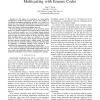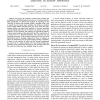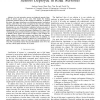INFOCOM
2008
IEEE
14 years 6 months ago
2008
IEEE
— In this paper, we concentrate on opportunistic scheduling for multicast information. We pose the problem as a multicast throughput optimization problem. As a solution we presen...
INFOCOM
2008
IEEE
14 years 6 months ago
2008
IEEE
—The design of computer and communication systems has been based, for decades, on the fundamental assumption that the objective of all users is to improve their own performance. ...
INFOCOM
2008
IEEE
14 years 6 months ago
2008
IEEE
—In multi-rate wireless LANs, throughput-based fair bandwidth allocation can lead to drastically reduced aggregate throughput. To balance aggregate throughput while serving users...
INFOCOM
2008
IEEE
14 years 6 months ago
2008
IEEE
Abstract—This paper investigates the speed limit of information propagation in large wireless networks, which provides fundamental understanding of the fastest information transp...
INFOCOM
2008
IEEE
14 years 6 months ago
2008
IEEE
—Sleep-wake scheduling is an effective mechanism to prolong the lifetime of energy-constrained wireless sensor networks. However, it incurs an additional delay for packet deliver...
INFOCOM
2008
IEEE
14 years 6 months ago
2008
IEEE
—It is important in communication networks to use routes that are as short as possible (i.e have low stretch) while keeping routing tables small. Recent advances in compact routi...
INFOCOM
2008
IEEE
14 years 6 months ago
2008
IEEE
—We study the problem of data-driven routing and navigation in a distributed sensor network over a continuous scalar field. Specifically, we address the problem of searching fo...
INFOCOM
2008
IEEE
14 years 6 months ago
2008
IEEE
Abstract—In road networks, sensors are deployed sparsely (hundreds of meters apart) to save costs. This makes the existing localization solutions based on the ranging be ineffect...
INFOCOM
2008
IEEE
14 years 6 months ago
2008
IEEE
—Recent deregulation initiatives enable cellular providers to sell excess spectrum for secondary usage. In this paper, we investigate the problem of optimal spot pricing of spect...
INFOCOM
2008
IEEE
14 years 6 months ago
2008
IEEE
—In this paper, we perform an extensive measurement study on a multi-tier mesh network serving 4,000 users. Such dense mesh deployments have high levels of interaction across het...






